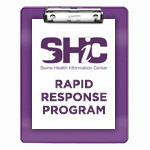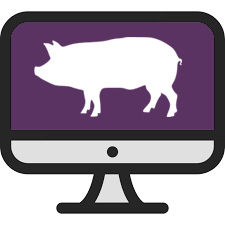
As the world deals with the COVID-19 pandemic, SHIC continues to focus efforts on prevention, preparedness, and response to novel and emerging swine disease for the benefit of US swine health. As a conduit of information and research, SHIC encourages sharing of its publications and research. Forward, reprint, and quote SHIC material freely. SHIC is funded by America’s pork producers to fulfill its mission to protect and enhance the health of the US swine herd. For more information, visit https://www.swinehealth.org or contact Dr. Sundberg at [email protected].

The Swine Health Information Center’s Rapid Response Program (SHIC’s RRP) is an important part of SHIC-supported emerging disease preparedness. It’s designed for epidemiological investigations of transboundary or newly emerging swine diseases and is carried out by the Rapid Response Corps (RRC). During 2020, SES Incorporated created and implemented an exercise to provide refresher training on the objectives, procedures, and implementation of the RRP for RRC investigators. The RRC exercise offered valuable continuing education, taking into consideration their geographically disparate locations. A series of virtual drills focused on the key phases of an RRC investigation: pre-investigation, investigation and post-investigation (reporting). Due to the differences in production facilities and practices for the various phases of hog production, drills were developed for the primary production phases: sow farms, nurseries, finishers (including wean-finish and gilt replacement) and boar stud operations.
During the RRP refresher, 30 participating RRC Investigators (practicing and consulting veterinarians, diagnosticians, and epidemiologists) also had the opportunity to identify areas and issues of weaknesses in the Program’s processes so they can be strengthened. The refresher included a self-administered pretest, a one-on-one session between the Corps member and a trainer to go through Program scenarios, practicing established procedures, including using the standard outbreak survey, and concluded with a self-administered post-test. Average score on the pretest was 81%. After the one-on-one sessions, the average score on the post-test rose to 90%.
Overall, the RRC Investigators were well-versed in asking open-ended questions. Most of the open-ended questions expanded on the questions included on the RRP Investigation Form and Summary Report. All the RRC Investigators provided justification for their risk assessments in the refresher scenarios. In most cases, they did not use the terminology in the RRC Investigator training, using instead language based on their knowledge of the industry, past experiences, and the geographical area where they were located.
All the RRC Investigators provided biosecurity suggestions during the refresher, as expected. Most gave biosecurity recommendations appropriate to the scenarios, but some did go beyond and offer suggestions on general practices as well.
The RRP is designed to cover the US with six defined regions. The six regions are small enough so Corps members from within the region can drive to outbreaks and be on the site within 72 hours of invitation being given by the affected producer. The refresher process identified three original RRC members who said they did not want to continue; they will be replaced by newly recruited and trained participants. The primary reason SHIC trains, maintains and funds the RRC is to quickly determine the pathway(s) by which an emerging disease made entry onto a given farm so that recommendations to prevent infection of other swine units can be rapidly circulated industry-wide.
The resources gathered for the RRC online training are available for all, regardless of interest in becoming a team member. By registering on the SHIC website, you can access the training modules which serve as an excellent aid for developing your own rapid response protocol. To learn more about the SHIC Rapid Response Program or provide input, contact SHIC Executive Director Dr. Paul Sundberg ([email protected]) or the program coordinator, Dr. Derald Holtkamp ([email protected]).
When asked for feedback on the drill, RRC Investigators identified the positive benefits of the SHIC RRC Process Refresher Drill as a review of the training and a refresher of the investigation process. SHIC will be acting on the recommendations of the participants to continually improve the RRP, ensuring readiness in the event of a transboundary or newly emerging swine disease outbreak. Corps members’ time commitment, significant expertise and passion for safeguarding the US swine herd, and effort to participate in the RRP are appreciated by SHIC.

During a webinar sponsored by the Swine Health Information Center (SHIC) and American Association of Swine Veterinarians (AASV), practitioners and diagnosticians discussed porcine astrovirus type 3 (PoAstV3) which has been causing central nervous system (CNS) disease for at least a decade. Disease can be difficult to diagnose and manage. PoAstV3, spread by the fecal-oral route, has been associated with paresis, paralysis, knuckling, incoordination, and lateral recumbency in pigs at various production stages. Click here to access the webinar.
Dr. Kayla Henness, herd veterinarian with The Maschhoffs, and Dr. Todd Williams, head of contract research at Pipestone Veterinary Services, shared their experience with PoAstV3 on the farm. Dr. Fabio Vannucci, University of Minnesota, and Dr. Bailey Arruda, Iowa State University, shared information on collecting the right tissues for submission and disease trends at veterinary diagnostic labs (VDLs).
Dr. Henness detailed the discovery of PoAstV3 on a 5000-head sow farm where it was initially assumed to be untreated lameness. The case fatality rate was between 90% and 100% when the animal was displaying neurologic symptoms with no response to treatment. Fresh lung, liver, kidney, and spleen were submitted to a VDL with no significant findings reported. When fixed and fresh cerebrum were submitted, PoAstV3 was diagnosed.
To combat the virus, Dr. Henness initiated a controlled exposure event with the goal of uniform exposure and immunity across the farm. She stated they used a protocol similar to a porcine epidemic diarrhea virus (PEDV) process. Based on results from testing, Dr. Henness and her team created the feedback material from post-farrowing gilt manure, piglet manure from litters less than five days old, distilled water, and table salt. Testing after exposure to the feedback materials showed a decrease in infection and sow mortality dropped as well.
Dr. Henness said The Maschhoffs are working with a third party lab on an experimental PoAstV3 vaccine using spinal cord sequenced from the affected farm. They also made extra exposure material as a backup to be used in the event of a flare up before the vaccine is ready.
In Dr. Williams situation, PoAstV3 was found in a 3000 sow farrow-to-wean facility in southeast Iowa with a traditionally high health flow. In this experience, a sow was good one day and bad the next, reluctant or unable to get up. The following day, the sow would not rise nor raise its head. There was no response to antibiotics or anti-inflammatories. The sow would be off feed and slightly lame on a front limb then rapidly progress to lateral incumbency.
Diagnostics on the three sows initially exhibiting the symptoms showed all had inflammatory changes in the brain consistent with a viral cause, per results of submission to a VDL. The neurologic exam on the sow farm showed nystagmus was mostly absent, palpebral reflex was positive, deep pain present to tail, and hyperesthesia. In the neurological exam of finishing pigs, nystagmus was positive as was palpebral reflex. Again, there was deep pain present to the tail as well as ataxia, muscle tremors/weakness, and hyperesthesia. Dr. Williams reported he also saw positive response to whole herd feedback, as well as in the gilt development unit feedback program at 18 weeks of age
Dr Fabio Vannucci shared information on sampling collection of the spinal cord for better diagnostic results, recommending a dehorner for the process. He also advised localizing CNS signs to collect the correct tissue samples for submission. To help the pathologist, he also said being specific about the CNS signs will be helpful for diagnosis.
Viral poliomyelitis appears similar regardless of cause, Dr. Fannucci cautioned, noting it will require ancillary tests for definitive diagnosis. He also suggested submitting non-CNS tissues (intestine, muscle, liver, serum) along with feed samples to ensure diagnosis.
Dr. Arruda said the Iowa State University VDL usually sees a handful a cases each month being tested for PoAstV3. She echoed the clinical signs shared during the webinar by the practitioners and pointed out that paresis of the front limbs is usually either porcine sapelovirus (PSV) or PoAstV3. She recommends aseptic collection of brainstem, spinal cord submission, and cerebrum for diagnostic accuracy. When an animal is down in back, for example, the caudal spinal cord is the appropriate sample. When down in front, the cranial spinal cord is preferred. She also says opening joints is important for best results. Picking the right pigs for the samples is essential as well, illustrating disease progression in samples will help, but not more than three pigs are needed when using a solid case definition.
Reviewing submission data from the Iowa State VDL, Dr. Arruda said cases of PoAstV3 have been diagnosed in animals from 20 days of age to sows. The case fatality rate is 90% to 100% with herd mortality from 0.1% to 10%. In a pig, PoAstV3 has a duration of less than four days. Within a group, it lasts weeks to months. Intergroup duration can extend to years. She also said treatment is generally unrewarding.
Dr. Arruda and colleagues have conducted field trials to further learn how to manage PoAstV3, details of which were shared during the webinar. Learning continues and unanswered questions remain. She said infection and fecal shedding are common, however, development of CNS disease is relatively uncommon.
SHIC/AASV sponsored webinars bring together subject matter experts to discuss current issues facing US pork producers and practitioners. Past topics have included viral myelitis, tracheitis, coccidiosis, and lameness/arthritis. Conducted by the Iowa State University Swine Medicine Education Center (SMEC), webinar participants include practitioners with first-hand experience with the topic being discussed, diagnosticians, and other experts. Completed webinars are posted online for convenient access here.
Do you have a recommendation for a topic to be addressed in this format? SHIC and AASV would like your input! Reach out to SHIC Executive Director Dr. Paul Sundberg at [email protected] or AASV Director of Public Health and Communications Dr. Abbey Canon at [email protected] with your webinar recommendations.
As the world deals with the COVID-19 pandemic, SHIC continues to focus efforts on prevention, preparedness, and response to novel
and emerging swine disease for the benefit of US swine health.

This month’s Domestic Swine Disease Monitoring Report shows that porcine reproductive and respiratory syndrome virus (PRRSV) detection was on the upper boundaries of the forecasted model at the end of November and beginning of December. There was a moderate increase in detection for porcine epidemic diarrhea virus (PEDV) in adult/sow farms, and porcine deltacoronavirus (PDCoV) in wean-to-market animals. Mycoplasma hyopneumoniae detection was similar to November. At a state level, PRRSV detection was three standard deviations above expected in Minnesota, Iowa, South Dakota, Nebraska, Missouri, and Indiana, PEDV in Illinois, PDCoV in Oklahoma and Illinois. The SDRS hosts talk with Dr. Deb Murray (New Fashion Pork) about her experiences using and applying veterinary diagnostic data for disease management and control in this month’s podcast.

In western Poland, African swine fever (ASF) has spread to a fourth province at the north border with Germany. Details are included in the January Global Swine Disease Monitoring Report which also includes information on a surge of ASF outbreaks in large commercial farms located in European (western) Russia. An ASF outbreak has also been reported in the Siberian region, the first outbreak in three years near the Kazakhstan border. In Namibia, new foot-and-mouth disease outbreaks keep moving westwards into the protection zone.
Copyright 2024 | Swinehealth.org | Website by Heartland Marketing Group